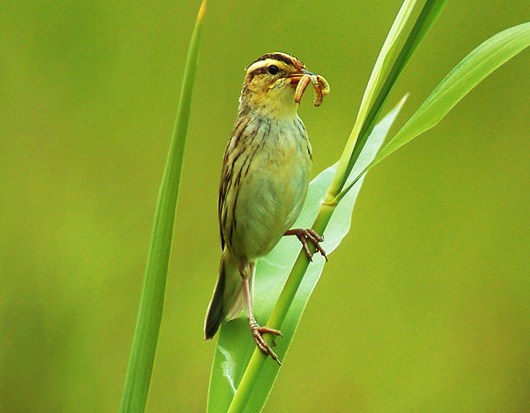Acrocephalus paludicola

Common name:
Taxonomy:
Order Passeriformes
Family Sylviidae
Range:
This species breeds across a highly fragmented range at less than 50 regular breeding sites in eastern Europe and near Asia, from eastern germany, through Hungary, Poland, Ukraine, Belarus, Lithuania and into south-western Russia. They migrate across western and southern Europa and over the Sahara, to winter in western Africa, namely in Senegal and Mali.
Size:
This medium-sized warbler is 11,5-13 cm long and has a wingspan of 17-19 cm. They weigh around 12 g.
Habitat:
The aquatic warbler breeds in large open lowland marsh habitats with low grassy vegetation (mostly sedge fen mires) with water mostly less than 10 cm deep. During migration they prefer reed beds with sedge and other low-lying vegetation close to open water, normally along rivers, estuaries and coastal lagoons. They also winter in marsh habitats, namely the grassy saline Scirpus marshes of the Senegal delta.
Diet:
This species is mostly insectivorous, taking small insects in dense, low vegetation. Occasionally they also eat berries.
Breeding:
Aquatic warblers breed in May-July. Each male will normally mate with more than one female. The nest is is a neatly but rather loosely constructed cup of grass, plant stems and leaves, spider webs, and plant down, lined finer material, typically placed over marshy ground or in a clump of sedge in shallow water. Females lay 4-6 eggs which are incubated by both parents for 12-15 days. The chicks fledge 13-14 days after hatching. This species produces 1-2 broods per year.
IUCN status – VU (Vulnerable)
This species as a large, but highly fragmented breeding range and a global population of just 22.000-30.000 individuals. The population probably declined rapidly until the late 1990s, as a result of the destruction of its habitat at a rate equivalent to 40% in ten years. The decline in the central European core population has recently been stopped owing to intensive management and conservation projects but other populations continue to decline through habitat loss and degradation owing to drainage for agriculture and peat extraction, damming of floodplains, unfavourable water management and the canalisation of rivers. Uncontrolled fires in spring and summer pose a direct threat to birds and nests, and can burn out the upper peat layer of fens. In the wintering grounds, agricultural cultivation and irrigation (creation of rice and sugar cane plantations), drought, wetland drainage, intensive grazing, succession to scrub, desertification and salinisation of irrigated soils are all potential threats.








